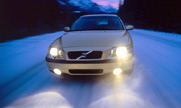Driving at Night

Driving at night is more dangerous than during the day. Here's how to play it
safe.
by
Peter D. duPre
Although
we do most of our driving during daylight hours, the Department Of
Transportation says that 57 percent of all traffic fatalities happen at night.
Reduced visibility, people driving under the influence or too fast for
conditions, poor weather, failure to stay alert, and unsafe vehicles all
contribute to the higher nighttime death toll.
It is
important, therefore, to minimize the risks by improving your vehicle and
driving carefully. Here are a few precautions you can take to increase your
nighttime safety quotient:
·
Clean the windows. Fogged windows, road film and fingerprints
decrease visibility. Clean the exterior glass every time you fill up and do the
interior surfaces once a week or whenever they look filmy or smudgy. Fill the
washer reservoir full of windshield cleaner and replace worn wiper blades.
·
Have headlights lights aligned. Have the headlights aligned to
provide maximum visibility. Keep a bottle of window cleaner and a roll of paper
towels in the vehicle to clean both headlights and taillights whenever you fill
up. Also, make sure that turn signals, parking lights, license plate lights and
taillights are clean and working.
·
Improve the lighting. While all new vehicles come equipped with
ultra-bright halogen lights, many older vehicles may not have these brighter
lamps. Replace the traditional lights with halogen or the newer, blue HID (High
Intensity Discharge) bulbs to improve visibility. You might also add a set of
fog/driving lights for better low beam visibility during inclement weather.
·
Be more visible. A clean car reflects light better than a dirty
one and looks nicer, too. So, wash up. Stick reflective tape to the bumpers and
side moldings to help others see you better.
·
Add a brake light. A third brake light can reduce the chances of
being rear-ended by as much as 30 percent. Owners of older vehicles without a
high-mounted, center rear brake light should have one installed.
·
Breakdown safety. Turn on the emergency flashers when you pull
over and before attempting any outside repairs, such as fixing a flat. Put on a
pair of white coveralls with reflective patches sewn into the fabric. Use
traffic flares and a safety reflector to alert others to your presence on the
side of the road.
·
Stay alert. Don't drive when tired or sleepy. A fatigued driver
has reduced reaction time and has an increased chance of falling asleep. Make
sure you are alert and awake. Keep the heat and the stereo down low. High heat
makes you drowsy and loud music distracts your attention from the traffic,
limiting your ability to hear horns and sirens.
·
Drive sober. Drunk drivers are a major cause of nighttime traffic
fatalities. Never, ever drink and drive. If you have had even one drink, wait an
hour or more before getting behind the wheel of a vehicle. If you've had more
than two drinks, call a cab and if you spot a drunk driver, call the police.
·
Slow down. Darkness reduces overall visibility and your ability to
properly judge distance. Decrease speed from the posted limit by 5 mph and
increase your following distance.
·
Drive defensively. Always give yourself an out. This means that no
matter what the traffic conditions, you have enough space to avoid trouble by
either stopping in time or by having the room to go around. Keep an eye out for
pedestrians, stray animals, cars without lights, bicyclists, drunks and other
road hazards. Stay clear of vehicles that are drifting or swerving and never
attempt to pass a vehicle that is obviously not under full control.
Peter duPre has been writing about cars and car care for over 30 years. He has authored automotive technical manuals and been published in numerous automotive magazines.